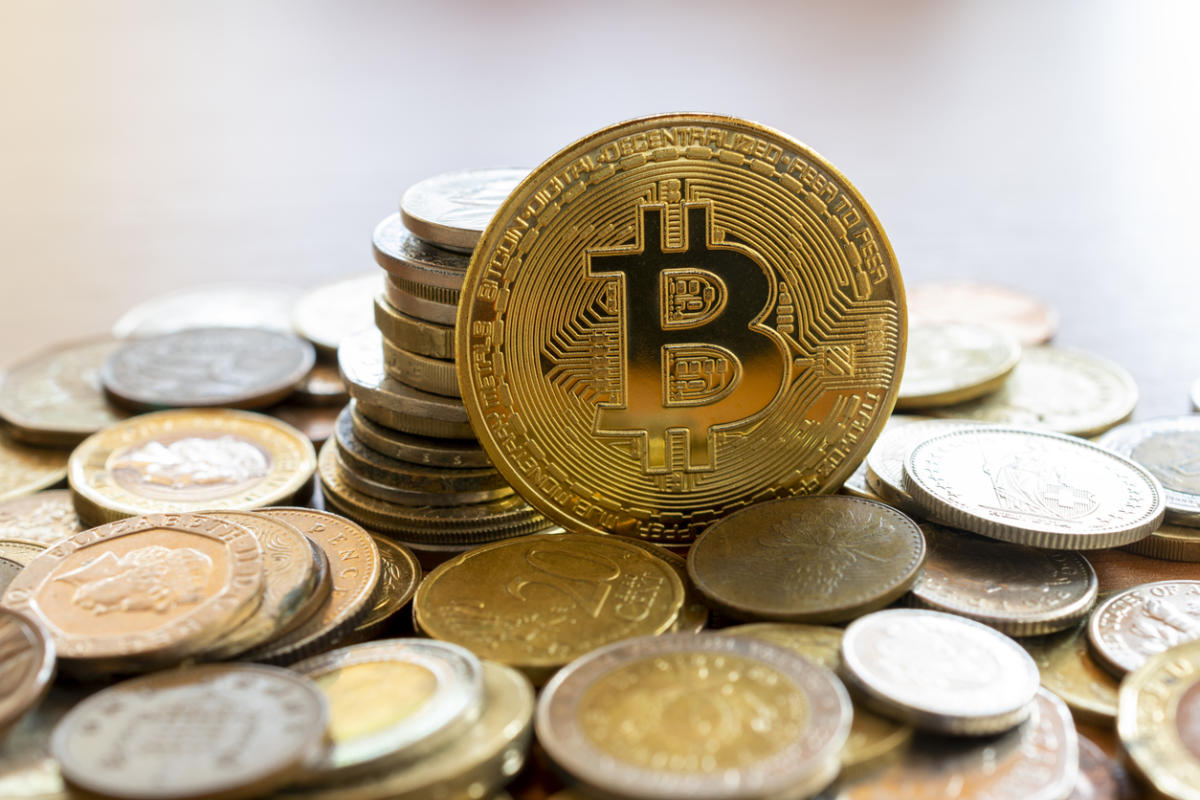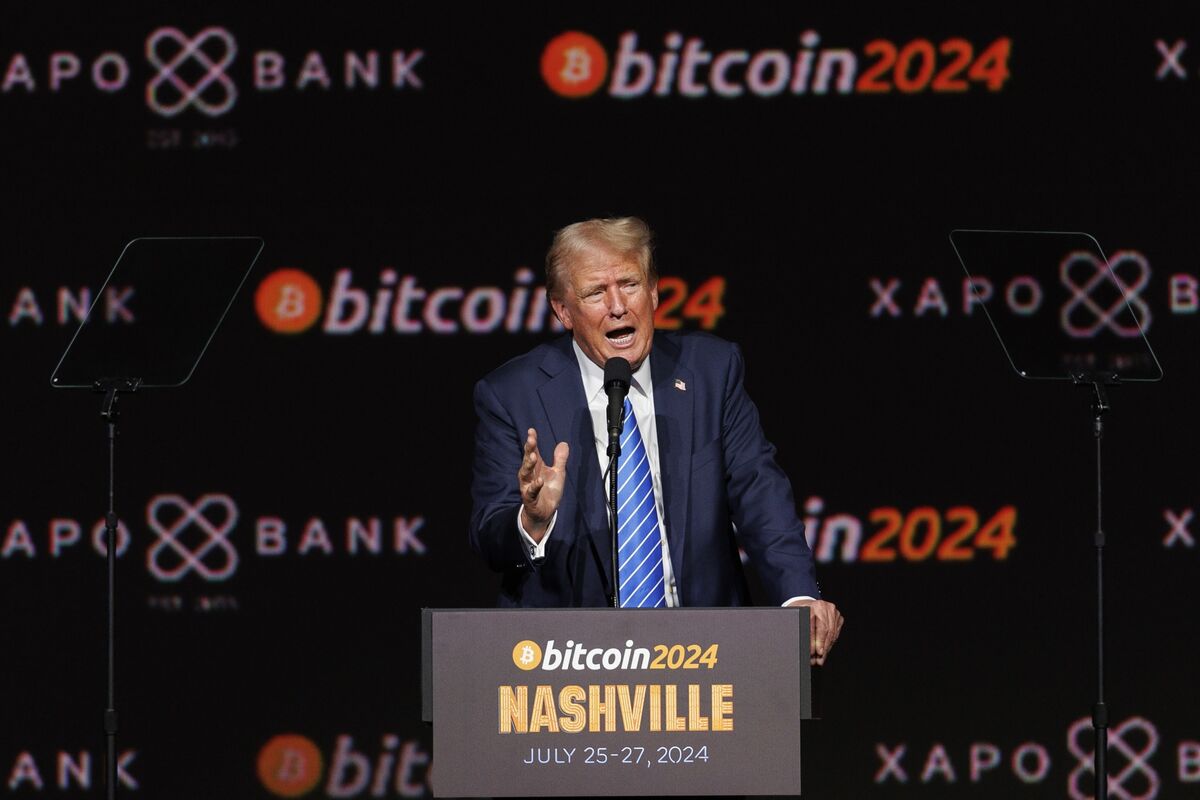Bitcoin
Inside latest crypto firm paying billions to end legal troubles

- Judge approves $4.5 billion settlement between Do Kwon, Terraform Labs, and the U.S. Securities and Exchange Commission.
- Binance previously settled with the U.S. in November for $4.3 billion.
- Recent spate of criminal convictions and fines mark resolution for multiple bad actors who helped upend crypto sector in 2022.
South Korean authorities are seeking the arrest of Do Kwon, co-founder and chief executive officer of Terraform Labs. His company is behind the now-collapsed terraUSD and luna cryptocurrencies. South Korean prosecutors are now seeking to freeze bitcoin linked to Kwon.
Woohae Cho | Bloomberg | Getty Images
Months before Sam Bankman-Fried and the FTX fraud was exposed, and years before Binance and its founder, Changpeng Zhao, would admit fault and settle with the U.S. for several billion dollars, Do Kwon was widely regarded as crypto’s top villain for nearly dismantling the entire sector with his failed U.S. dollar-pegged stablecoin.
It was May 2022, and Kwon was riding high. His company, Terraform Labs, was behind one of the most popular U.S.-pegged stablecoins on the planet, the venture funding was rolling in, his coins (dubbed terra and luna) were collectively worth tens of billions of dollars, and like Bankman-Fried, Kwon had landed a spot on the prestigious Forbes 30 under 30 list.
Perhaps in his greatest show of confidence in the empire he had built, just one month before it all collapsed, Kwon posted that he named his newborn daughter Luna. “My dearest creation named after my greatest invention,” he wrote.
And then it all came crashing down.
Whereas most stablecoins are backed up by a mix of cash and other assets to match the value of tokens in circulation, Kwon’s invention was instead backed by a complex set of code. When the algorithm failed in May 2022, it cost investors $40 billion in market value overnight, led to devastating losses to multiple investors, and contributed to the collapse of hedge fund Three Arrows Capital in June 2022, followed by crypto lenders Voyager Digital, then BlockFi, then Genesis — and, in a roundabout way, FTX too.
The stablecoin’s implosion also rocked confidence in the sector and accelerated the slide in cryptocurrencies already underway as part of a broader pullback from risk.
In the years since, U.S. criminal, civil, and bankruptcy courts have been cleaning up the wreckage, in part, by prosecuting bad actors and fining fallen firms. This week, a judge signed off on Do Kwon and his bankrupt Terraform Labs settling with the U.S. Securities and Exchange Commission for $4.5 billion. This comes after a jury unanimously found Kwon and his company liable for securities fraud following less than two hours of deliberation.
How Kwon, who is currently in the Balkans — or Terraform Labs, which remains in bankruptcy and, according to court testimony, only has around $150 million in assets — will be able to pay the fine remains unclear. But it does serve as the latest example of crypto’s bad actors atoning for past sins.
Read more about tech and crypto from CNBC Pro
In April, Binance’s founder and ex-CEO was sentenced to four months in prison after settling with the U.S. Justice Department, Commodity Futures Trading Commission and the Treasury Department for $4.3 billion in November. A few weeks before that, in March, the FTX founder and ex-CEO was sentenced to 25 years in prison. Celsius CEO Alex Mashinsky starts his jury trial later this year, in September.
The washout of crypto’s previous class of tycoons comes as the digital asset market matures and gains the backing of Wall Street’s top brass.
Token prices are in the midst of a bull run, with bitcoin reaching a new all-time-high above $73,000 in March. Meanwhile, some of the biggest names in traditional finance have jumped into crypto in the last year, as firms including BlackRock and Fidelity issue billions of dollars worth of spot bitcoin exchange-traded funds in the U.S.
Here’s a rundown of where the culprits who nearly blew up crypto are today, including those who remain on the lam.
A police officer escorts Terraform Labs co-founder Do Kwon after he served a sentence for document forgery in Podgorica, Montenegro, March 23, 2024.
Stevo Vasiljevic | Reuters
Kwon is currently living in a sort of legal and social purgatory in the Balkans.
The 32-year-old fugitive is holed up in Montenegro after months on the run that involved leaving Singapore for a mix of destinations, including Dubai, Serbia, and Montenegro. He’s been there since March of last year, following a failed attempt to flee from Podgorica to Dubai on a jet with a fake passport. Do Kwon is out on bail but bound to the Balkan state, until the country’s Supreme Court decides whether to ship him back home to South Korea to face trial, or to the United States, where the former crypto tycoon has been tried in absentia and found guilty on civil charges.
As for criminal repercussions for Kwon, it all depends on what the Montenegrins decide.
U.S. judges have been coming down hard on the crypto criminals who cost retail investors tens of billions of dollars, but South Korea doesn’t plan to go easy either, with one prosecutor reportedly saying that he expected Kwon to face the longest jail term for a financial crime in the country’s history, which could top 40 years.
The crime goes back to the fall of terraUSD (UST) and its sister token luna in May 2022, which had been one of the most popular U.S. dollar-pegged stablecoin projects.
Kwon had a knack for convincing people to buy what he was selling. Most notably, he sold his vision of a new kind of payment system that would upend the status quo and replace the world’s currencies.
TerraUSD (also called UST) and its sister token, luna, moved in lockstep. UST functioned as a U.S. dollar-pegged stablecoin meant to replace global fiat transactions, while luna helped UST keep its peg and earned investors a killing as it appreciated in value. (In 2021, luna was up 15,800%.) Traders were also able to arbitrage the system and profit from deviations in the prices of the two tokens.
The setup wasn’t new. Algorithmic stablecoins, which rely on a complex set of code rather than hard currency reserves to stabilize their price, had been a thing since at least 2015 — and the idea of staking crypto to earn an unrealistically high return exploded in popularity alongside the rise of decentralized finance, or DeFi.
But Kwon had a real touch for marketing. He cast himself in the likeness of a next-gen Satoshi Nakamoto (the pseudonymous name given to the founder of bitcoin), crossed with the social media swagger of an Elon Musk.
Kwon raised $207 million for his Terraform Labs, which launched luna and UST, and an aggressive online posture, in which he shunned the “poor” (that is, luna skeptics) on Twitter, drew in the masses. He inspired an almost cult-like following of self-identifying LUNAtics — including billionaire investor Mike Novogratz, who went so far as to memorialize his membership in this club with a tattoo on his arm.
Terra’s Anchor platform, which really helped to put UST on the map with its outsized return of 20%, could have been a big red flag for savvy investors. Many analysts believed it was unsustainable. At the time, government bonds were paying around 2% and savings accounts less than 1%. But investors piled in anyway, giving luna and UST a combined market value of almost $40 billion at one point.
Overnight, both tokens plunged in value and were essentially worthless. The failure was so massive, it helped drag down the entire crypto asset class, erasing half a trillion dollars from the sector’s market cap. It also dented investor confidence in the whole space.
It was reportedly Kwon’s second failed attempt at launching an algorithmic stablecoin, though his first effort saw losses in the range of tens of millions of dollars, rather than tens of billions.
“This case affirms what court after court has said: The economic realities of a product — not the labels, the spin, or the hype — determine whether it is a security under the securities laws,” said SEC Chair Gary Gensler in a press release.
“Terraform and Do Kwon’s fraudulent activities caused devastating losses for investors, in some cases wiping out entire life savings. Their fraud serves as a reminder that, when firms fail to comply with the law, investors get hurt. Terraform and Kwon fought our efforts to investigate – taking a fight over investigative subpoenas all the way to the Supreme Court. Thankfully, with this settlement, the victims of their massive fraud will now get some justice.”
NEW YORK, US – JANUARY 03: Sam Bankman-Fried leaves the court in New York, on January 03, 2023.
Fatih Aktas | Anadolu Agency | Getty Images
FTX founder Sam Bankman-Fried was sentenced to 25 years in prison in March for the massive fraud and conspiracy that doomed his cryptocurrency exchange and a related hedge fund, Alameda Research.
The sentence in Manhattan federal court was significantly less than the 40 to 50 years in prison that federal prosecutors wanted for Bankman-Fried, but it was much more than the five to six-and-a-half years suggested by his attorneys.
“There is a risk that this man will be in position to do something very bad in the future,” Judge Lewis Kaplan said before sentencing the 32-year-old and ordering him to pay $11 billion in forfeiture to the U.S. government.
“And it’s not a trivial risk at all,” Kaplan added.
Kaplan noted he has never heard “a word of remorse for the commission of terrible crimes” from Bankman-Fried.
The judge said that in the 30 years on the federal bench, he had “never seen a performance” like Bankman-Fried’s trial testimony.
If Bankman-Fried was not “outright lying” during cross-examination by prosecutors, he was “evasive,” Kaplan said.
“There is absolutely no doubt that Mr. Bankman-Fried’s name right now is pretty much mud around the world,” the judge said.
Jurors at trial likewise did not buy Bankman-Fried’s version of events, convicting him in November of seven criminal counts and holding him responsible for losing about $10 billion in customer money due to the securities fraud conspiracy.
Prosecutors said Bankman-Fried led a conspiracy to loot customer money to make investments, fund political donations to both Democrats and Republicans, and for his personal use, as well as to repay loans taken out by Alameda Research.
Bankman-Fried plans to appeal his conviction and sentence.
Ryan Salame, a former top lieutenant of FTX founder Sam Bankman-Fried, has been sentenced to 90 months, or seven and a half years, in prison, followed by three years of supervised release.
Three other people, who all testified against Bankman-Fried at trial, are awaiting their own sentencings after pleading guilty to criminal charges related to FTX and Alameda Research.
They are Caroline Ellison, the Alameda Research CEO who at one time dated Bankman-Fried; FTX engineering chief Nishad Singh; and Gary Wang, the co-founder and chief technology officer of FTX.
In May, the bankruptcy estate of FTX announced that almost all customers would get their money back — and more. The collapsed exchange said it has between $14.5 billion and $16.3 billion to distribute to creditors and that FTX users whose claims were $50,000 or less would receive approximately 118% of the amount of their allowed claim, according to the proposed reorganization plan.
Former Binance CEO Changpeng Zhao, center, departs federal court in Seattle on April 30, 2024.
Jason Redmond | AFP | Getty Images
Binance’s billionaire founder Changpeng Zhao has reported to a low-security federal prison in Lompoc, California, according to the Bureau of Prisons website.
Zhao was sentenced to four months in prison in April after pleading guilty to charges of enabling money laundering at his crypto exchange.
The sentence handed down to the former Binance chief was significantly less than the three years that federal prosecutors had been seeking for him. The defense had asked for five months of probation. The sentencing guidelines called for a prison term of 12 to 18 months.
“I’m sorry,” Zhao told U.S. District Judge Richard Jones before receiving his sentence, according to Reuters.
“I believe the first step of taking responsibility is to fully recognize the mistakes,” Zhao reportedly said in court. “Here I failed to implement an adequate anti-money laundering program. … I realize now the seriousness of that mistake.”
In November, Zhao, commonly known as “CZ,” struck a deal with the U.S. government to resolve a multiyear investigation into Binance, the world’s largest cryptocurrency exchange. As part of the settlement, Zhao stepped down as the company’s CEO.
Though he is no longer running the company, Zhao is widely reported to have an estimated 90% stake in Binance.
The scope of his alleged crimes included willfully failing to implement an effective anti-money laundering program as required by the Bank Secrecy Act, and allowing Binance to process transactions involving proceeds of unlawful activity, including between Americans and individuals in sanctions jurisdictions.
The U.S. ordered Binance to pay $4.3 billion in fines and forfeiture. Zhao agreed to pay a $50 million fine. The SEC was noticeably absent from the joint effort by the DOJ, CFTC and Treasury against Binance and its founder.
Voyager said it has roughly $1.3 billion of crypto on its platform and holds over $350 million in cash on behalf of customers at New York’s Metropolitan Commercial Bank.
Justin Sullivan | Getty Images
The fall of crypto hedge fund Three Arrows Capital, and lenders Voyager Digital and Celsius, can all be traced to the collapse of Kwon’s stablecoin project.
When 3AC’s lenders asked for some of their cash back in a flood of margin calls, the money wasn’t there. Many of the firm’s counterparties were, in turn, unable to meet demands from their investors, including retail holders who had been promised annual returns of 20%.
The three companies all went bankrupt and are currently at various stages of settling their debts, with Celsius having just emerged from bankruptcy in January.
Celsius’ ex-CEO Mashinsky faces criminal trial in the U.S. later this year, while 3AC co-founder Kyle Davies says he’s not sorry for the collapse of his fund, and has so far managed to avoid jail time altogether by bouncing around the world, unlike his co-founder, Su Zhu, who served time in a Singaporean prison.
Bitcoin
Grayscale Unveils Bitcoin Mini Trust ETF

Bitcoin Currency
Grayscale Investments The Bitcoin Mini Trust began trading on Wednesday with a 0.15% expense ratio, offering a lower-cost option for bitcoin exposure in the market.
The Mini Trust, which has the symbol BTC and trades on NYSE Arca, is structured as a spin-off of the Grayscale Bitcoin Trust (GBTC). New shares will be distributed to existing GBTC shareholders with the fund contributing a portion of its bitcoin holdings to the new product. According to a company press releaseBTC’s S-1 registration statement became effective last week.
“The Grayscale team has believed in the transformative potential of Bitcoin since the initial launch of GBTC in 2013, and we are excited to launch the Grayscale Bitcoin Mini Trust to help further lower the barrier to entry for Bitcoin in an SEC-regulated investment vehicle,” said David LaValle, Senior Managing Director and Head of ETFs at Grayscale.
The Bitcoin Mini Trust’s debut comes amid growing interest in ETFs based on the current price of the two largest cryptocurrencies by market cap, bitcoin and ether. Spot bitcoin ETFs have generated nearly $18 billion in inflows since the first ones began trading on Jan. 11, though GBTC has lost nearly $19 billion in assets.
This fund differs from other funds because it is a conversion of an existing fund and has a 1.5% fee, the highest among spot bitcoin products that have received SEC approval this year.
Mini Bitcoin Trust Low Fee
On a Post X On Wednesday, Bloomberg senior ETF analyst Eric Balchunas noted the Bitcoin Mini Trust’s “lowest fee in the category…”
“[Important] to recognize how incredibly cheap 15bps is — about 10x cheaper than spot ETFs in other countries and other vehicles,” Balchunas wrote, adding that this pricing strategy reflects the competitive nature of the U.S. ETF market, which he referred to as the “ETF Terrordome.”
“This is what Terrordome does to fund [cost]. It reaches 1.5% [and] end in 0.15%, how to go from [a] country club to the jungle. But that’s why all the flows are here, investor paradise,” he noted.
Read more: Spot Bitcoin ETF Inflows Hit Daily High of Over $1 Billion
Bitcoin was recently trading at around $66,350, virtually flat since U.S. markets opened on Wednesday.


Grayscale also offers two spot Ethereum ETFs, the Grayscale Ethereum Trust (ETHE) and the Grayscale Ethereum (ETH) Mini Trustwhose performance is based on ETHE. ETHE outflows exceeded $1.8 billion in its first six days of trading, while ETH added more than $181 million in the same period, according to Farside. The remaining seven ETFs generated about $1.2 billion in inflows.
The story continues
Read more: Spot Ethereum ETFs Approved to Start Trading
Permanent link | © Copyright 2024 etf.com. All rights reserved
Bitcoin
Bitcoin (BTC) Price Drops Below $65K After FOMC as Middle East Tensions Rise

Cryptocurrencies fell sharply on Wednesday as rising geopolitical risks captivated investors’ attention following the conclusion of the Federal Reserve’s July meeting.
Bitcoin (BTC) fell to $64,500 from around $66,500, where it traded following Federal Reserve Chairman Jerome Powell’s press conference and is down more than 2% in the past 24 hours. Major altcoins including ether (ETH)sunbathing (SUN)Avalanche AVAX (AVAX) and Cardano (ADA) also fell, while Ripple’s XRP saved some of its early gains today. The broad cryptocurrency market benchmark CoinDesk 20 Index was 0.8% lower than 24 hours ago.
The liquidation happened when the New York Times reported that Iran’s leaders have ordered retaliation against Israel over the killing of Hamas leader Ismail Haniyeh in Tehran, raising the risk of a wider conflict in the region.
Earlier today, the Fed left benchmark interest rates unchanged and gave little indication that a widely expected rate cut in September is a given. The Fed’s Powell said that while no decision has been made on a September cut, the “broad sense is that we are getting closer” to cutting rates.
While digital assets suffered losses, most traditional asset classes rose higher during the day. U.S. 10-year bond yields fell 10 basis points, while gold rose 1.5% to $2,450, slightly below its record highs, and WTI crude oil prices rose 5%. Stocks also rallied during the day, with the tech-heavy Nasdaq 100 index rebounding 3% and the S&P 500 closing the session 2.2% higher, led by 12% gains in chipmaker giant Nvidia (NVDA).
The different performances across asset classes could be due to traders’ positioning ahead of the Fed meeting, Zach Pandl, head of research at Grayscale, said in an emailed note.
“Equities may have been slightly underutilized after the recent dip, while bitcoin is coming off a strong period with solid inflows, while gold has recovered after a period of weakness,” he said.
“Overall, the combination of Fed rate cuts, bipartisan focus on cryptocurrency policy issues, and the prospect of a second Trump administration that could advocate for a weaker U.S. dollar should be viewed as very positive for bitcoin,” he concluded.
UPDATE (July 31, 2024, 21:30 UTC): Adds grayscale comments.
Bitcoin
Donald Trump’s Cryptocurrency Enthusiasm Is Just Another Scam

Former US President Donald Trump spoke at the Libertarian National Convention in May and lent his a strong support to crypto: “I will also stop Joe Biden’s crusade to crush crypto. … I will ensure that the future of crypto and the future of bitcoin is made in the US, not taken overseas. I will support the right to self-custody. To the 50 million crypto holders in the country, I say this: With your vote, I will keep Elizabeth Warren and her henchmen out of your bitcoin.”
Former US President Donald Trump spoke at the Libertarian National Convention in May and lent his a strong support to crypto: “I will also stop Joe Biden’s crusade to crush crypto. … I will ensure that the future of crypto and the future of bitcoin is made in the US, not taken overseas. I will support the right to self-custody. To the 50 million crypto holders in the country, I say this: With your vote, I will keep Elizabeth Warren and her henchmen out of your bitcoin.”
Trump continued to court the cryptocurrency industry in the months that followed; he he appeared at the Bitcoin 2024 Conference in Nashville this week, along with independent presidential candidate Robert F. Kennedy Jr.’s parting words to Trump — “Have fun with your bitcoin, your cryptocurrency and whatever else you’re playing with” — were less than enthusiastic, but the industry itself remains packed with ardent Trump supporters.
This turnaround came as a surprise, given Trump’s previous strong opposition to cryptocurrency. When Facebook was floating its Libra cryptocurrency in 2019, Trump tweeted: “I am not a fan of Bitcoin and other cryptocurrencies, which are not money, and whose value is highly volatile and based on thin air.” Former national security adviser John Bolton’s White House memoir, The Room Where It Happened, quotes Trump as telling Treasury Secretary Steven Mnuchin: “Don’t be a trade negotiator. Go after Bitcoin.” [for fraud].” In 2021, Trump counted Fox Business that bitcoin “just looks like a scam. … I want the dollar to be the world’s currency.”
Why the change? There doesn’t seem to be any crypto votes. Trump’s “50 million” number comes from a poorly sampled push survey by cryptocurrency exchange Coinbase which claimed 52 million cryptocurrency users in the United States starting in February 2023. But one survey A survey conducted last October by the US Federal Reserve showed that only 7% of adults (about 18.3 million people) admitted to owning or using cryptocurrencies — down from 10% in 2022 and 12% in 2021. Many of these people are likely wallet owners who were left holding the bag after crypto plunged in 2022 — and are not necessarily new fans.
What Trump wants from the cryptocurrency industry is money. The cryptocurrency industry has already raised more than US$ 180 million to run in the 2024 US elections through his super PACs Fairshake, Defend American Jobs and Protect Progress.
Fairshake spent $10 million on taking Rep. Katie Porter in the primary battle for Dianne Feinstein’s California Senate seat by funding Porter’s pro-crypto rival Adam Schiff. This put $2 million to knock out Rep. Jamaal Bowman in the Democratic primary for New York’s 16th District in favor of pro-crypto George Latimer. In the Utah Senate Republican primary, Rep. John Curtis defeated Trent Staggs with the help of $4.7 million from Defend American Jobs. In Alabama’s House District 2, the majority of campaign expenses came from the cryptocurrency industry.
Fairshake is substantially financed by Coinbase, cryptocurrency issuer Ripple Labs, and Silicon Valley venture capital firm Andreessen Horowitz, or a16z. Silicon Valley was awash in cryptocurrencies during the 2021 bubble, and a16z in particular continues to promote blockchain startups to this day — and still holds a huge amount of bubble crypto tokens that he wishes he could cash in on.
Many in Silicon Valley would like an authoritarian who they think will let them run wild with money — while bailing them out in tough times. Indeed, Trump promised Bitcoin 2024 participants that he hold all bitcoins that the United States acquires. (Never mind that it is usually acquired as the proceeds of crime.) Silicon Valley explicitly sees regulation of any kind as its greatest enemy. Three a16z manifestos — “Politics and the Future” It is “The Techno-Optimist Manifesto” and 2024 “The Small Tech Agenda—describe co-founders Marc Andreessen and Ben Horowitz’s demands for a technology-powered capitalism unhindered by regulation or social considerations. They name “experts,” “bureaucracy,” and “social responsibility” as their “enemies.” Their 2024 statement alleges that banks are unfairly cutting off startups from the banking system; these would be crypto companies funded by a16z.
Trump’s vice presidential pick, Senator J.D. Vance, is a former Silicon Valley venture capitalist. He was once employed by Peter Thiel, who bankrolled Vance’s successful 2022 Senate run; Vance has been described as a “Thiel creation”. He has increased support for the Trump ticket among his venture capital associates. Vance is a bitcoin holder and a frequent advocate of encryption. He recently released a draft bill to review how the Securities and Exchange Commission (SEC) and the Commodity Futures Trading Commission (CFTC) control crypto assets. In 2023, he circulated a bill to prevent banks from cutting out cryptocurrency exchanges.
Minimal regulation has been tried before. It led to the wild exuberance of the 1920s, which ended with the Black Tuesday crash of 1929 and the Great Depression of the 1930s. Regulators like the SEC were put in place during this era to protect investors and transform the securities market from a jungle into a well-tended garden, leading to many prosperous and stable decades that followed.
Crypto provides the opposite of a stable and functional system; it is a practical example of how a lack of regulation allows opportunists and scammers to cause large-scale disasters. The 2022 Crypto Crash repeated the 2008 financial crisis in miniature. FTX’s Sam Bankman-Fried was feted as a financial prodigy who would perform economic miracles if you just gave him carte blanche; he ended up stealing billions of dollars of customers’ money, destroying the lives of ordinary people, and is now in a prison cell.
U.S. regulators have long been concerned about the prospect of cryptocurrency contagion to the broader economy. Criminal money laundering is rampant in cryptocurrency; even the Trump administration has made rules in December 2020 to reduce the risk of money laundering from crypto. Meanwhile, the crypto industry has persistently tried to infiltrate systemically risky corners of the economy, such as pension funds.
Four U.S. banks collapsed during the 2023 banking crisis, the first since 2020. Two of them, Silvergate Bank and Signature Bank, were deeply embedded in the crypto world — Silvergate in particular appears to have collapsed directly from its heavy reliance on FTX and failed a few months after that. Silicon Valley Bank was not involved in crypto but collapsed due to a run on the bench due to panic among venture capital deposit holders, particularly Thiel’s Founders Fund.
Project 2025the Heritage Foundation mammoth conservative wish list The plan, which Trump and Vance have both endorsed and tried to distance themselves from at various times, emphasizes the importance of party loyalists, noting especially financial regulation. The plan recommends replacing as much of the federal bureaucracy as possible with loyalists and “trusted” career officials rather than nonpartisan “experts.” Vance defended in 2021 that Trump should “fire every mid-level bureaucrat, every civil servant in the administrative state” and “replace them with our people.” Loyalty will likely trump competence.
Crypto is barely mentioned directly in Project 2025 — suggesting it has little active support among the broader conservative coalition. But near the end of the manifesto is a plan to dismantle most U.S. financial regulations and investor protections put in place since the 1930s, suggesting the exemption the crypto industry seeks from current SEC and CFTC regulations.
Bitcoin, the first cryptocurrency, started as an ideological project to promote a strange variant of Murray Rothbard’s anarcho-capitalism and the Austrian gold-backed economy—the kind we abandoned to escape the Great Depression. Crypto quickly co-opted the “end of the Fed” and “establishment elites” conspiracy theories of the John Birch Society and Eustace Mullins. It’s a way for billionaire capitalists like Thiel, Andreessen and Elon Musk to claim they’re not part of the so-called elite.
If a second Trump administration were to limp along with financial regulators and allow cryptocurrencies to have free rein, it could help foster the collapse of the U.S. economy that bitcoin claimed to prevent. But Trump is more likely to be happy to take the crypto money and run.
Bitcoin
Trump’s Bitcoin (BTC) Reserve Plan Seen as Just a ‘Small Token Stash’

Donald Trump’s recent promise to create a “strategic national stockpile of Bitcoin” may not turn out to be as big a commitment as the hype surrounding the announcement makes it seem.
“Trump’s proposal is extremely modest,” said George Selgin, director emeritus of the Center for Monetary and Financial Alternatives at the Cato Institutea Washington-based public policy group. “It doesn’t have much economic implication.”
-

 Ethereum12 months ago
Ethereum12 months agoEthereum Posts First Consecutive Monthly Losses Since August 2023 on New ETFs
-

 Regulation12 months ago
Regulation12 months agoCryptocurrency Regulation in Slovenia 2024
-

 News12 months ago
News12 months agoNew bill pushes Department of Veterans Affairs to examine how blockchain can improve its work
-

 Regulation12 months ago
Regulation12 months agoThink You Own Your Crypto? New UK Law Would Ensure It – DL News
-

 Regulation12 months ago
Regulation12 months agoUpbit, Coinone, Bithumb Face New Fees Under South Korea’s Cryptocurrency Law
-

 Regulation12 months ago
Regulation12 months agoA Blank Slate for Cryptocurrencies: Kamala Harris’ Regulatory Opportunity
-

 Regulation12 months ago
Regulation12 months agoBahamas Passes Cryptocurrency Bill Designed to Prevent FTX, Terra Disasters
-

 Regulation12 months ago
Regulation12 months agoIndia to Follow G20 Policy for Cryptocurrency Regulation: MoS Finance
-

 News1 year ago
News1 year ago“Captain Tsubasa – RIVALS” launches on Oasys Blockchain
-

 Ethereum1 year ago
Ethereum1 year agoComment deux frères auraient dérobé 25 millions de dollars lors d’un braquage d’Ethereum de 12 secondes • The Register
-

 News12 months ago
News12 months agoEU supports 15 startups to fight online disinformation with blockchain
-

 News1 year ago
News1 year agoSolana ranks the fastest blockchain in the world, surpassing Ethereum, Polygon ⋆ ZyCrypto













